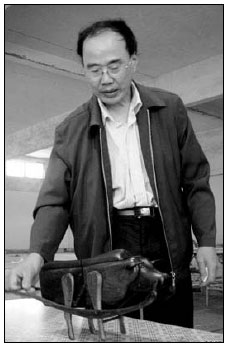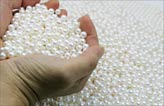Chinese Way
Varnishing the truth
Updated: 2011-06-09 07:57
By Liu Jun (China Daily)
|
Wu Dingwu (below) and his student Zhang Qichun (right in the picture above) believe they have solved one of the oldest and most fascinating puzzles in Chinese history: the muniu liuma invented by Zhuge Liang some 1,700 years ago. Photos by Gong Guorong / for China Daily |

Two master carpenters from Zhejiang province claim to have cracked an abiding puzzle of Chinese history. Liu Jun reports.
Wu Dingwu lifts and presses a U-shaped handle attached to an exquisitely carved wooden ox, and it starts clip-clopping forward. With not a single nail, spring, or gear wheel used in its construction, the ox, some 15 cm tall and 30 cm long, can carry iron blocks weighing up to 6 kg in its belly.
Wu, 57, is a carpenter from Ninghai county, about 60 km to the south of Ningbo city, Zhejiang province. He and his student Zhang Qichun, 43, believe they have solved one of the oldest and most fascinating puzzles in Chinese history: the muniu liuma invented by Zhuge Liang some 1,700 years ago.
During the Three Kingdoms Period (AD 220-280), military strategist Zhuge led the Shu Kingdom army to battle the Wei Kingdom led by Sima Yi.
Annals of the Three Kingdoms (Sanguo Zhi), written by Chen Shou in the 3rd century, says Zhuge invented two devices called muniu liuma ("wooden ox and running horse") to transport supplies to the battlefront, across wood-planked mountain paths. Mysteriously, when attacked by the enemy these "vehicles", with their bounteous supplies, were left untouched.
Unfortunately, there are no records giving an illustration of this ingenious invention.
Over the centuries, numerous people have tried to make their own versions of the muniu liuma, creating an interesting branch of study for the Three Kingdoms Period.
"If I had lived in the old days, I would have done a better job than Zhuge Liang, who was not a carpenter," says Wu, whose invention won a patent from the State Intellectual Property Office in June 2010 and drew many visitors at the Zhejiang Root-Carving Exhibition, held in Ninghai from May 27 to 30.
"Many people say muniu liuma is a mystery, (but) it's not difficult for us (to conceive). All you need is to put yourself back in ancient times and think about the materials and technology available then."
In August 2009, Wu saw several modern versions of muniu liuma in the program Approach to Science on Channel 10 of China Central Television. Experts said none of them fits the descriptions given in historical records.
Zu Chongzhi (AD 429-500), a mathematician and astronomer known for his approximation of pi (ratio of the circumference of a circle to its diameter), is also credited with a version of the muniu liuma, but no images exist of that either.
The program's host concluded that the ancient mystery could be solved only if the tomb of Zhuge Liang was found with his original draft inside.
This got Wu laughing. One of seven brothers, Wu picked up his carpentry skills not only from his father, Wu Deyuan, but also other master carpenters.
"If the best carpenters in the world are to be found in China, then the best Chinese carpenters come from Zhejiang's Qiantong town of Ninghai county. That's where the ace of the aces are," says Zhang, who was apprenticed to Wu at 16.
Even though neither of them made it to college, the pair are gifted with sharp brains and adroit hands.
In about six months, they figured out a simple way to get the ox moving. In their wooden ox, the handle is linked to the legs and mouth, and has a flexible neck, knees and waist.
The fulcrum, located near the ox's waist, is what controls the movement, Zhang says.
When they tested it on a larger model, 70 cm tall and 1.87 meters long, the ox walked stiffly at first. They then adjusted the fulcrum by a few centimeters till it moved smoothly.
The other crucial part of the ox is the tongue which, Wu says, is what links the head and body. Just like the description in historical records, a twist of the tongue immobilizes the ox. That explains why the supplies, hidden in the bellies of the immobile oxen, were abandoned on the battlefield by the enemy all those years ago.
Zhang estimates a life-sized model can carry up to 300 kg. This fits the records that say each animal could carry enough provisions to feed 10 soldiers for one month.
Although Zhang says they have tested the ox on mountain roads, their invention has not satisfied all experts.
Feng Lisheng, director of the Institute for History of Science and Technology & Ancient Texts at Tsinghua University, says the use of levers to propel the ox forward does not fit the historical descriptions, as the ox's hoofs could get stuck in the grooves where the wooden planks join.
"Efficiency is what the military need. And the four legs aren't efficient," says Feng, who believes the wheels used in other versions are probably closer to reality.
Feng says he has lost count of the number of people who have contacted him about their conceptions of the muniu liuma over the years.
"The lack of detail in historical records makes this a fascinating puzzle," Feng says.
The name "ox" and "horse" probably didn't mean the actual appearance, he says. The "horse" might be a smaller but faster vehicle carrying less weight than the bigger, slower "ox".
Wu and Zhang have already found customers for their invention.
A museum in Dalian, Liaoning province, has booked two big oxen, made of rosewood, at 16,000 yuan ($2,470) each, for display. The pair has also sold seven smaller oxen at 3,900 yuan a piece.
"This is not about the wood, it's about culture," Zhang says. "For those who know nothing about ancient China, even 1,000 yuan for an ox is too expensive."
The intrepid inventors are now working on a machine that can churn out binder clips. Hailed as the "hometown of stationery", Ninghai sends some 100 tons of pencil boxes, pen holders and paper clips all over the world everyday.
At present, a skilled worker can assemble 30 binder clips in one minute. That is very costly, especially in view of the shortage of labor in the past few years, Wu says.
Their invention will make it possible for one worker to monitor 10 machines, each of which can put together 90 binder clips in one minute.
While Wu focuses on his inventions, Zhang runs a factory with some 20 skilled carpenters.
"The revival of ancient culture is becoming stronger. You can see it in furniture, architecture, dress and hairstyles," Zhang says.
Despite their skills, Zhang says their creations are not money-spinners. His friends jokingly call him "Master Prototype": Whenever he turns out something, copies sprout all over Shanghai in a week.
That's one reason for patenting his wooden ox. "We want to protect our intellectual property rights," Zhang says.
Master Wu, meanwhile, dreams of spending his whole life in his lab. "I have two idols: Zhuge Liang and inventor (Thomas) Edison," he says.
"What is important is not how much money you make, but how much you contribute to society."
Specials

Birthday a new 'starting point'
China's national English language newspaper aims for a top-notch international all-media group.

Room at the inn
The Chinese hotel industry experiences a building boom, prompting fears of oversupply.

Pearls of wisdom
Chinese pearl farmers dominate the world market but now want to work smarter, not harder
